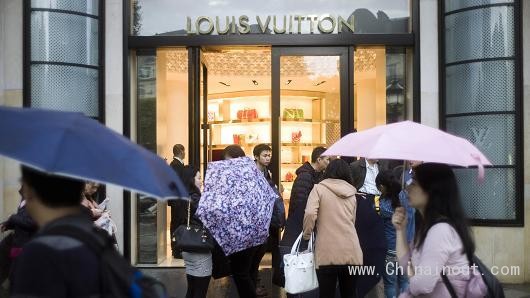
美国贝恩公司称,奢侈品在中国的销量增长正面临压力,中国奢侈品市场规模占全球市场总规模的约1/3。以全世界最大奢侈品公司路威酩轩集团为例,今年第一季度亚洲内销售额同比下降6%。
不过,中国消费者仍在购买奢侈品。他们只是不在中国购买。2014年,中国本土奢侈品销售额降至约250亿美元,降幅达11%。然而,设在上海的财富品质研究院称,与此同时中国消费者在海外购买奢侈品的开支增长9%,达到810亿美元。
摩根士丹利公司估计,在中国消费者创造的奢侈品销售额中,有一半以上是在海外市场消费:有的是在出国旅游期间购买,有的则是通过水货市场购买。
这种做法不仅影响奢侈品公司对商品的控制,也损害了它们在亚洲的商业策略。
有些公司则作出反应:香奈儿今年早些时候在中国采取降价举措,同时提高了一些主打产品的欧洲售价,以缩小两地差价。奢侈品公司需要解决根本的定价问题。有些公司正在向中国市场推出价格更亲民的奢侈品,这样既缩小了差价,同时不影响现有的商品销售。
对于奢侈品行业来说,统一售价事实上可能是未来的流行趋势。(中国进出口网)
According to a report from the "The Wall Street Journal" website, over the years, the world's largest luxury goods companies typically make the price of luxuries sold in mainland China and Hong Kong 25-40% higher than the price in the European countries.
The US company Bain said, luxury goods sales growth in China was under pressure, the Chinese luxury goods market size accounted for about 1/3 of the total global market size. Take the world's largest luxury goods company LVMH Group for example, in the first quarter of this year its sales in Asia decreased by 6%.
However, Chinese consumers are still buying luxury goods. They just are buying luxury goods in China. In 2014, China's domestic luxury goods sales dropped to about $ 25 billion, a dro of 11%. However, the Shanghai wealth quality research institute said that at the same time the expenditure that Chinese consumers spend on luxury goods abroad rose 9% to $ 81 billion.
Morgan Stanley estimated that in the luxury goods sales Chinese consumers created, more than half of them were achieved in the overseas market: some buy luxury goods during travel abroad, others buy luxury goods by the gray market.
This practice not only affects the luxury goods companies’ control on goods, but also hurts their business strategies in Asia.
In the earlier this year Chanel took measures to cut price in China, while increasing the price of some of Europe's flagship products, in order to reduce the price difference between the two areas. Luxury goods companies need to address the fundamental problem of pricing. Some companies are introducing luxury goods with lower prices in the Chinese market, which narrows the price difference, but does not affect existing merchandise sales.
For the luxury goods industry, the uniform price may in fact be the trend in the future.











